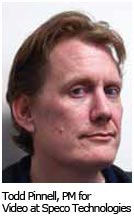A common complaint about system specifications is people sometimes cut and paste words from A&E and other product documents. “It produces not a true system, which could never work as described or is very inefficient,” Pigram said. “The normal cut-and-paste job is not truly understanding what customers want and building a system like a bad jigsaw puzzle.”
The bottom line is to not only look at data sheets but figure out if the camera fits user requirements, especially when it comes to motion, low-light handling and stable frame rate without frame drops, Christensson said.
Some users assume 10-megapixel is better than 1 or 2, but do not see overall problems with lenses and storage. “They want real-time and 30 fps — these expectations cannot be served,” Schreiber said. “If you have a well-educated integrator, he will know what is possible and communicate with the end user. But there are still some very ridiculous requirements, such as seeing with no light or looking behind walls.”
CSI Effect
 While megapixel sees a great deal, it still has limitations. “From Hollywood, users see ‘CSI' or ‘Mission Impossible' closing in on villains,” said Vance Kozik, PM at StarDot Technologies. “However, a camera can't see 500 meters to read a license plate. Hollywood has presented something that can't be done yet.”
While megapixel sees a great deal, it still has limitations. “From Hollywood, users see ‘CSI' or ‘Mission Impossible' closing in on villains,” said Vance Kozik, PM at StarDot Technologies. “However, a camera can't see 500 meters to read a license plate. Hollywood has presented something that can't be done yet.”
While a 5-megapixel camera equals the resolution of 15 D1 cameras, it doesn't mean users can digitally zoom half a mile away and recognize a face, Kozik added.
As Hollywood investigators identify villains from reflections or at great distances, user expectations have increased for megapixel. “This market is close to the consumer one,” Schreiber said. “Most are not highly trained or in engineering. When they look at TV and watch ‘CSI Miami,' they will see the police identifying a car from 1 kilometer away. This is fake, but the fakery of TV and the movies has moved to their industry expectations.”
While a megapixel camera might not spot a terrorist three miles away, increases in processing and better illumination have improved image capture. Technology is closing the gap between reality and fantasy, with faster processors ensuring more accurate and better analytics as well as sharper images. High-resolution camera installation requires planning for displays, storage and networks, as well as overcoming integration hurdles. Extra preparation and understanding will go a long way toward ensuring solid megapixel camera performance.